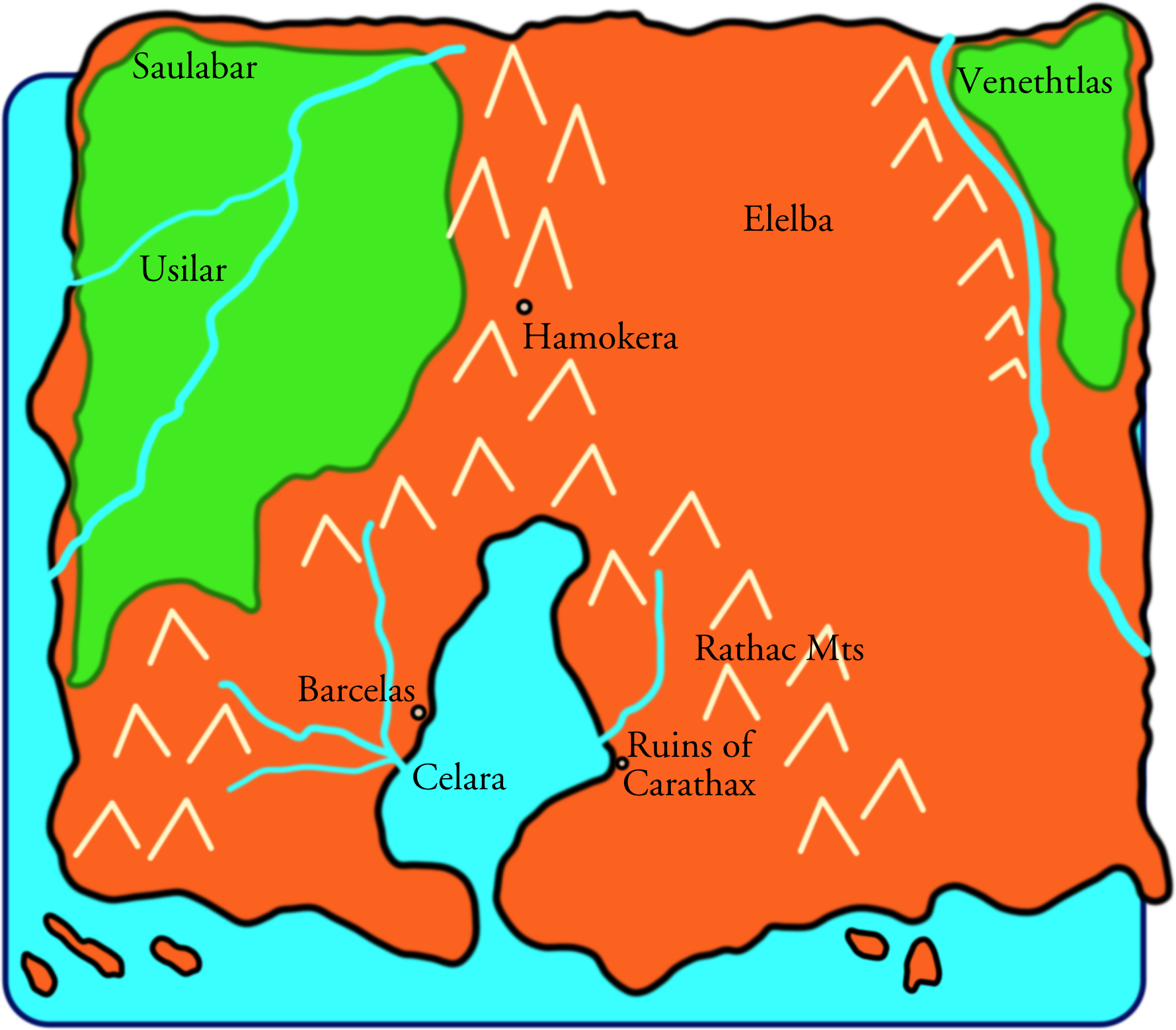As you open the door, you smell fresh air and see sunlight filtering through the widening crack in the door.
Beyond the open door you see trees, bushes, ferns, and tall grass, all green and lush. The trees are set in a circle of which you are the center. A few yards ahead of you is a small stone bench. Around the grove, partially in and out of the trees, statues of odd persons or creatures stare back at you with elongated snouts, perched strangely forward.
A small animal, perhaps a squirrel, crawls over one of the statues and into the trees.
Pillars of stone stand between the statues, and the ruins of something, perhaps arches, lie amidst the ruins.
The door to Barcelas opens in the side of a small mountain, in a grove outside of Barcelas in the world of Barcelas. There are seven statues of Barcelasians: Saurians wearing robes, some holding scrolls, some swords, some tools. There were once arches surrounding the grove. They have fallen to the ground, though the pillars mostly remain.
Some two hundred yards east of the grove, the forest opens up on a plateau overlooking the Celara.
The forest opens up and you are standing atop a high mountain, looking down upon a great blue sea. To your right, a river pours into the sea, and to your left a great city some miles wide lies on the shore of the sea.
The vista resembles the painting in the foyer of the Blue Sun, except that the city is not as vibrant. The world of Barcelas is another land in decline. Though they have not seen the effects of the cataclysm, the energy is still draining from their world. The Barcelasian empire has fallen and nothing has risen to take its place. Barcelas, long abandoned by anything resembling civilization, remains a war-torn city of factions of barbarians: Usilar, Saulabar, and saurians competing for the now meaningless Aquali throne.
The city is a long day’s walk from the grove, about twelve miles down a mountain path and across first thin forest and then fields. The fields were once farmed, but now stand fallow.
The History of Barcelas
It is Barcelasian Year 3465. Political bickering dominates the last Barcelasian city, Hamokera in the north, though Hamokera at least remains civilization. A succession of petty foreign kings has “ruled” the royal section of the city of Barcelas since its final sack four hundred years past. The ruler does not even control the entire city.
For over three thousand years the Barcelasian Empire ruled the known world. Starting from the small town of Barcelas on the shores of Celara, the bipedal lizard-like Barcelasians expanded to conquer or ally with first their near neighbors, then their less-near neighbors, until the Barcelasian Empire covered parts of three continents and several large islands off the coasts of those continents. Until Barcelasian Year 2285, the Empire was a republic of nearly free client states. The only requirements were that each client state provide troops for the armed forces, and that each client state grant Barcelasian citizens a franchise in electing local officials.
The backbone of the Empire was their citizen-soldiers, first composed only of true Barcelas, and later of all races under Barcelasian rule. They were well-trained, ruthless in battle, obedient in war, and learned in peace.
In their early years, the chief Barcelasian rival was the great spider-race of Carathax on the opposite shore of the Celara. Several wars were fought between Barcelas and Carathax before Carathax was finally razed to the ground and forcibly depopulated. Many were taken into slavery. Others fled into the Rathac mountains where they skulk in cavern and shadow to this day.
In BY 2285, a civil war began that ended in military rule. Military rule grew to emperor rule. The Prelins, or supreme rulers, of Barcelas claimed divine power.
Towards the end of the second millennia, the edges of the empire began to see Usilar, pale bipedal creatures (humans) from the north, who began to chip away at Barcelasian conquest. At first they were mere gnats on the Barcelasian elephant. But as the military state grew more autocratic, as civil wars inside grew more bloody, the borders began to grow weaker. Finally, in BY3065, after their own lands were invaded by wolf-riding Saulabar (goblins) to the north, a massive wave of Usilar invasions caused Markesh Prelin to recall all Barcelasian troops back to Barcelas. Even this was not enough: Barcelas was sacked, its power destroyed and an Usilar Prelin placed on the Aquali Throne.
But this emperor barely ruled Barcelas itself, let alone the rest of the empire. Cites, long walled, became states of their own. Some banded together. Many fell empty. More and more Usilar arrived and created their own villages, towns, and cities. Except for one outpost of civilization, the cities of Barcelas fell into ruin.
Fell into ruin except in one city, in the mountain pass between west and east, the city-state of Hamokera, recently converted to the worship of Na-el, grew in power in that small region of the world. Hamokera rarely knows peace: with the Usilar to their west and the growing Fictates of Elelba on their east, this mountain empire must continually defend itself. But it is well situated, and defend itself it has, to this day.
Na-el is a minor deity from a once minor religion in the Elelban desert. Once a simple, communal sect of an already small religion, over its centuries in Hamokera it has been caught up in Hamokeran factionalism and political maneuvering. It now more closely resembles Hamokeran culture than its Elelban roots.
Beyond even Elelba is rumored the great kingdom of Venethtlas, home of the ruddy, tall Elves who are known only for the Elvencord (Venetia) that comes to Hamokera through Elelba. Their Barcelas-given name, prosaic as all things Barcelasian, means simply “land of cord”.

